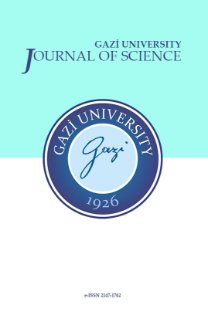A Suggestion System According to Fabric Control Time
A Suggestion System According to Fabric Control Time
Fabric defect Feature extraction, Defect recognition,
___
- [1] Shi, M., Jiang, S., Wang, H., Xu, B., “A simplified pulse-coupled neural network for adaptive segmentation of fabric defects”, Machine Vision and Applications, 20(2): 131-138, (2009).
- [2] Kaynar, O., Işik, Y. E., Görmez, Y., Demirkoparan, F., “Fabric defect detection with LBP-GLCM”, International Artificial Intelligence and Data Processing Symposium, 1-5, (2017).
- [3] Zhang, L., Jing, J., Zhang, H., “Fabric defect classification based on LBP and GLCM”, Journal of Fiber Bioengineering and Informatics, 8(1): 81-89, (2015).
- [4] Huang, C. C., Chen, I. C., “Neural-fuzzy classification for fabric defects”, Textile Research Journal, 71(3): 220-224, (2001).
- [5] Beljadid, A., Tannouche, A., Balouki, A., “Application of deep learning for the detection of default in fabric texture”, 6th International Conference on Optimization and Applications, Morocco, (2020).
- [6] Wang, C., Wang, D., Wang, R., Leng, J., “Textile defect detection and classification based on deep convolution neural network”, Developments of Artificial Intelligence Technologies in Computation and Robotics: Proceedings of the 14th International FLINS Conference, 1094-1101, (2020).
- [7] Jing, J., Wang, Z., Rätsch, M., Zhang, H., “Mobile-Unet: An efficient convolutional neural network for fabric defect detection”, Textile Research Journal, 1-13, (2020).
- [8] Wei, B., Hao, K., Tang, X. S., Ding, Y., “A new method using the convolutional neural network with compressive sensing for fabric defect classification based on small sample sizes”, Textile Research Journal, 89(17): 3539-3555, (2019).
- [9] Ghosh, A., Guha, T., Bhar, R. B., Das, S., “Pattern classification of fabric defects using support vector machines”, International Journal of Clothing Science and Technology, 142-151, (2011).
- [10] Salem, Y. B., Abdelkrim, M. N., “Texture classification of fabric defects using machine learning”, International Journal of Electrical and Computer Engineering, 10(4): 4390, (2020).
- [11] Cuifang, Z., Yu, C., Jiacheng, M., “Fabric defect detection algorithm based on PHOG and SVM”, Indian Journal of Fibre & Textile Research, 45(1): 123-126, (2020).
- [12] Abdellah, H., Ahmed, R., Slimane, O., “Defect detection and identification in textile fabric by SVM method”, International Organization of Scientific Research Journal of Engineering, 4(12): 69-77, (2014).
- [13] Ben Salem, Y., Nasri, S., “Woven fabric defects detection based on texture classification algorithm”, 8th International Multi-Conference on Systems, Signals & Devices, Tunisia, (2011).
- [14] Murino, V., Bicego, M., Rossi, I. A., “Statistical classification of raw textile defects”, Proceedings of the 17th International Conference on Pattern Recognition, United States, (2004).
- [15] Yildiz, K., Buldu, A., “Wavelet transform and principal component analysis in fabric defect detection and classification”, Pamukkale University Journal of Engineering Science, 23: 622-627, (2017).
- [16] Patil, M., Patil, S. R., “Fabric defect detection using discrete wavelet transform”, International Research Journal of Engineering and Technology, 6(6): 3495-3499, (2017).
- [17] Deotale, N. T., Sarode, T. K., “Fabric defect detection adopting combined GLCM, Gabor wavelet features and random decision forest”, 3D Research, 10(1): 5, (2019).
- [18] Silvestre-Blanes, J., Albero-Albero, T., Miralles, I., Pérez-Llorens, R., Moreno, J., “A Public Fabric Database for Defect Detection Methods and Results”, Autex Research Journal, 19(4): 363-374, (2019).
- [19] Yang, T. N., Wang, S. D., “Robust algorithms for principal component analysis”, Pattern Recognition Letters, 20(9): 927-933, (1999).
- [20] Tekeli, E., Cetin, M., Ercil, A., “A local binary patterns and shape priors based texture segmentation method”, IEEE 15th Signal Processing and Communications Applications, Turkey, (2007).
- [21] Nabiyev, V. V., Günay, A., “LBP yardımıyla görüntüdeki kişinin yaşının bulunması”, Çankaya University Journal of Science and Engineering, 8(1): 27-41, (2010).
- [22] Horak, K., Klecka, J., Bostik, O., Davidek, D., “Classification of SURF image features by selected machine learning algorithms”, 40th International Conference on Telecommunications and Signal Processing, Spain, (2017).
- [23] Zhu, W., Zeng, N., Wang, N., “Sensitivity, specificity, accuracy, associated confidence interval and ROC analysis with practical SAS implementations”, NESUG proceedings: health care and life sciences, Baltimore, Maryland, 19: 67, (2010).
- [24] Tabassian, M., Ghaderi, R., Ebrahimpour, R., “Knitted fabric defect classification for uncertain labels based on Dempster–Shafer theory of evidence”, Expert Systems with Applications, 38(5), 5259-5267, (2011).
- Yayın Aralığı: 4
- Başlangıç: 1988
- Yayıncı: Gazi Üniversitesi, Fen Bilimleri Enstitüsü
Hormatollah POURREZA, Ezzatallah BALOUİ JAMKHANEH, Einolah DEİRİ, Harish GARG
LSTM-Based Deep Learning Methods for Prediction of Earthquakes Using Ionospheric Data
Majeed ZAİDAN, Ghanim HASAN, Mudhar AL-OBAİDİ
Zekeriya PARLAK, Mustafa Ertürk SÖYLEMEZ, İsmail ŞAHİN
Knowledge Discovery from Library Automation via Bibliomining using the Apriori Algorithm
Joseph EMEGHA, Bolutife OLOFİNJANA, Kingsley UKHUREBOR, Uyiosa AİGBE, Samuel AZİ, Marcus ELERUJA
Meryem SEFERİNOGLU, Derya DÜZENLİ
P Naga SRİNİVASU, Norita NORWAWİ, Shanmuk Srinivas AMİRİPALLİ, P DEEPALAKSHMİ
A Comparative Analysis of the Ranking Functions for the IVIFVs and A New Score Function
